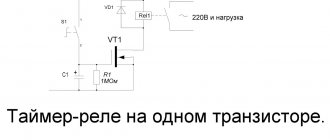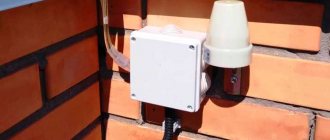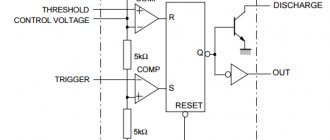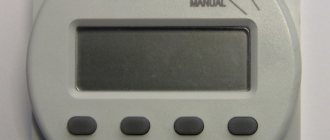Time relay, timer. Setup and connection diagram
An electronic time relay is designed to count time intervals, automatically turn on/off various electrical equipment (lighting, heating, etc.) after a specified period of time during a repeating weekly cycle.
For example: to turn on and off the lighting of a courtyard, park or street; to turn on and off the night lighting of staircases of apartment buildings; to turn on and off advertising signs and display windows at night; to control the inclusion of electric heating in a house; for automatic watering of plants;
to create the effect of presence in the house
Powered by a household power supply, voltage 220 Volts (it is possible to order relays for voltages of 12, 24, 36, 110 Volts). You can program it for the whole week or any day of the week, turning it on and off one or more times during the day. All data are displayed on the liquid crystal display. When the power supply is turned off, it retains the programming mode due to the built-in battery.
The service life of the time relay is from three to five years.
Specifications
ParameterValue
| Rated operating voltage | 220V |
| Mains frequency | 50/60Hz |
| Remains operational when the supply voltage is within | 180V-250V |
| Relay power consumption | no more than 2VA |
| Permissible switching contact current, with active load | 16A |
| Permissible switching contact current, with reactive load | 8A |
| Minimum programming step | 1 minute |
| Maximum programming step | 168 hours |
| Number of on/off programs | 16 cycles |
| Mechanical wear resistance, on/off cycles | 10⁷ |
| Electrical durability, on/off cycles | 10⁵ |
| Programming data storage time when power is turned off | up to 150 hours |
| Accuracy of the watch during the day, at a temperature of +25°C | ≤1 second |
| Overall dimensions (HxWxD) | 86.5x36x65.5 mm |
| Operating temperature range, °C | -10°С~+40°С |
| Relative humidity | 35~85% |
DIN rail mounting (takes two S-type modules), the size of a two-phase circuit breaker. Operate indoors with artificial ventilation and heating control.
Time relay front panel
Purpose of time relay control and indication buttons
Purpose of buttons and indicationsInscription
| Indication of contact activation | ON |
| Programming button | |
| Day of week setting button | D+ |
| Hour setting button | H+ |
| Minute setting button | M+ |
| Setting and current time button | |
| Reset all data button | RESET |
| Mode control button (ON, AUTO, OFF) | MANUAL |
Liquid crystal display
LCD Display Data
At the top of the display: days of the week
MO - Monday; TU - Tuesday; WE —environment; TH - Thursday; FR - Friday; SA - Saturday; SU - Sunday.
The day of the week is set using the D+ . In the middle part of the display: current and programmable time
The time is set using the , H+ and M+
In the lower left part of the display: numbers of on and off cycles
ON - enabled; OFF - disabled; numbers from 1 to 16 are the cycle number.
Cycles are configured using the button In the lower right part of the display: control mode
ON - always on; AUTO - automatic mode; OFF - permanently disabled.
The control mode is set using the MANUAL
Setting up a time relay
It is recommended to start with the RESET (press gently with a thin screwdriver; no force is required). After pressing, the display goes blank and then all elements are displayed, all settings and the current time are reset.
Setting up a time relay begins with setting the day of the week and the current time. We press (with our fingers) and hold the button (hereinafter referred to as clock ) and press the D+ , select the current day of the week, continue to hold down the clock , and use the H+ and M+ to set the current time.
After setting the current time and day of the week, we proceed to programming the time relay.
Programming a time relay
Programming is activated using the button (hereinafter referred to as programming ).
1) Press the programming to turn on the first switching cycle, then use the D+ , H+ and M+ to select the day of the week and switching . 2) Press the programming to turn on the first shutdown cycle, then use the D+ , H+ and M+ to select the day of the week and shutdown . If necessary, you can add several more on and off cycles by adjusting the second, third, etc. cycles.
Time relay connection diagram
Approximate connection diagram for time relay and load
Download instructions (passport) for time relay
Step-by-step instructions for setting up and programming an electronic weekly time relay can be downloaded or printed for free here; a passport describing and assigning time relay control buttons; programming and setting algorithm
download the instructions (passport) for the time relay, in Russian
download the instructions (passport) for the time relay, in English
time relay, time relay buy, electronic timer, TE 15, time relay circuit, time relay 220 Volt, programmable time relay, gravity watering timer, shutdown timer, relay, electronic programmable timer, with non-volatile memory, switching current 16 amperes, full range time from 1 minute to 168 hours, 16 programs, THC 15A, download time relay passport in Russian, download time relay instructions in Russian
Source: https://electromaster.kz/instructions/88-rele-vremeni-elektronnoe-nedelnoe
Specifications
| Parameter | Meaning |
| Rated operating voltage | 220V |
| Mains frequency | 50/60Hz |
| Remains operational when the supply voltage is within | 180V-250V |
| Relay power consumption | no more than 2VA |
| Permissible switching contact current, with active load | 16A |
| Permissible switching contact current, with reactive load | 8A |
| Minimum programming step | 1 minute |
| Maximum programming step | 168 hours |
| Number of on/off programs | 16 cycles |
| Mechanical wear resistance, on/off cycles | 10000000 |
| Electrical durability, on/off cycles | 100000 |
| Programming data storage time when power is turned off | up to 150 hours |
| Accuracy of the watch during the day, at a temperature of +25°C | ≤1 second |
| Overall dimensions (HxWxD) | 86.5x36x65.5 mm |
| Operating temperature range, °C | -10°С~+40°С |
| Relative humidity | 35~85% |
DIN rail mounting (takes two S-type modules), the size of a two-phase circuit breaker. Operate indoors with artificial ventilation and heating control.
Time relay for street lighting setting
Light sensor for street lighting is widely used to illuminate streets at night. This is very convenient because it saves electricity and does not need to be turned on and off with your hands.
Today, light sensors are in great demand in lighting private homes and local areas. Also, economical photo relays illuminate the space indoors. Installed near stairs and doors for convenience. We will provide a detailed description, provide a connection diagram, explain the principle of operation and give the necessary recommendations for use.
Rules
It should be noted that to regulate the supply of light at dusk and turn it off at dawn, two types of devices are used: a photo relay and an astro-timer.
The rule by which street lighting sensors operate is a simple chain of actions:
- A part that responds to the presence or absence of light changes its resistance when the intensity of light in the surrounding area changes. As a rule, this function is performed by a photodiode or resistor. In rare cases, a triac or thyristor.
- In order for the photocell to work, a special signal is sent through the adjustment circuit, which reaches the transistor.
- The transistor includes a relay, which is placed in the load network; after receiving the signal, its contacts begin to receive a load. And the light source comes into an active state of operation.
Economical time relay for outdoor lighting
When designing outdoor lighting, the designer should also think about saving energy. The standard outdoor lighting control scheme turns on the lighting in the evening and turns off the lighting in the morning. Today I’ll tell you about a special relay for controlling outdoor lighting.
Relatively recently, on the blog, I already talked about the outdoor lighting control scheme and this article can be considered a continuation of that topic.
There are two ways to achieve energy savings when operating outdoor lighting or illuminated advertising:
- The use of lamps with high luminous efficiency, lamps with high efficiency.
- As a result of organizational measures.
While LED lamps are quite expensive and pay for themselves in a year at best. Therefore, as of today, nothing can be squeezed out of the first option and we will not see savings anytime soon.
How to set up a time relay for street lighting - All about electricity
An electronic time relay is designed to count time intervals, automatically turn on/off various electrical equipment (lighting, heating, etc.) after a specified period of time during a repeating weekly cycle.
For example: to turn on and off the lighting of a courtyard, park or street; to turn on and off the night lighting of staircases of apartment buildings; to turn on and off advertising signs and display windows at night; to control the inclusion of electric heating in a house; for automatic watering of plants;
to create the effect of presence in the house
Powered by a household power supply, voltage 220 Volts (it is possible to order relays for voltages of 12, 24, 36, 110 Volts). You can program it for the whole week or any day of the week, turning it on and off one or more times during the day. All data are displayed on the liquid crystal display. When the power supply is turned off, it retains the programming mode due to the built-in battery.
The service life of the time relay is from three to five years.
Light on/off timer, photo relay on 555 timer
Light on and off timers are electrical devices that can be used to organize automatic lighting control. Suitable for domestic and industrial consumers.
Including timers in the lighting network design can significantly reduce the cost of expensive electricity and simplify the control of outdoor lighting, because in this case, there is no need to be on site to turn the light on and off.
There are a large number of models of timers and switches that are used for different lighting networks.
Lanterns with a timer for street lightingLight switch with a timerLighting network diagram with a timer
Light switch with timer
According to the type of installation, automatic light switching relays are distinguished, mounted:
- On the wall. It is necessary to install on an insulating base; a protective laying of cable and wire products should be provided.
- In the socket. It is necessary to select socket boxes of the appropriate size.
- On DIN rail. Installed on all boxes designed for modular electrical equipment. At the same time, it is possible to control the light from several places.
Lighting timer type TO-2
The light switching timer of the TO-2 series is designed for constant automatic switching on of the lighting system (turning it off at night) according to an autonomous table of the movement of the Sun. Also used as a time relay, which turns on lighting networks at a selected period of time. The maximum lighting load for 1 device is no more than 1 kW.
Application
- Security lighting of facility areas, emergency lighting of non-residential buildings. In this mode, the timer turns on the lamps after sunset and turns off at sunrise.
- Lighting of areas of garden association houses and local areas. Identical to the first mode. It is also possible to turn off the lighting load at a specified time interval.
- Billboard lighting. Operating mode – only during the designated time period.
Principle of operation
- The controller compares the readings of the built-in clock with an astronomical table and transmits signals to two relays.
- Relay No. 1 turns on the timer for the light only according to the readings of the built-in clock.
- Relay No. 2 works similarly, there is also an additional function to turn off the load for a certain period of time (set by settings).
Device settings
It consists of setting the date and time for the correct operation of the twilight relay. Settings are controlled using buttons located on the front panel of the device.
Advantages
- Availability of a six-digit indicator;
- Possibility of installation on DIN rail;
- Reducing financial costs for electricity;
- Equipment resistance to temperature changes;
- Ability to operate in 50…300 V networks;
- Fast reprogramming;
- Saving the specified settings when the external power is turned off;
- Electronic display that displays device parameters.
Important! To connect a large load, the circuit must be supplemented with contactors and additional relays.
Preparatory work before turning on the device
- Select the electrical connection diagram (for large load values, use contactors);
- Install the device and switch in the lighting control panel;
- Connect the device with cables or wires to the power supply and lamps via a relay;
- Apply voltage to the device.
Models of the TO-2 series are programmed to be able to shift the relay response time (up to 127 minutes in both directions).
It is recommended to carry out technical inspection and routine diagnostics of the device at least once every six months. The terminal blocks and fastening of the timer, the connection points of the electrical circuit elements are subject to inspection.
Modes
- Indications. Normal operating mode, the display shows all timer operating parameters at the current time.
- Settings. Set the current date and time.
- Checks. Test mode to check the functionality of the device.
- Settings. Correction of previously set operating values of the device.
Important! Calibration and repairs of timers must be performed at specialized service centers or at manufacturing plants.
Lighting timer type TO-47
Models of the TO-47 series are designed for automatically turning on and off lighting networks with halogen and incandescent lamps on landings and other premises. The device turns on the lighting for a period of 1 to 7 minutes. The maximum load on the device is 3.5 kV.
Staircase lighting control
Device connection options
The light off timer can operate in three-wire and four-wire electrical networks (the products are specially equipped with a switch for the number of wires).
- When choosing scheme No. 1 (three-wire networks), the circuit is assembled without the possibility of connecting an additional lighting load after the switch;
- Scheme No. 2 is four-wire with the ability to connect additional lamps (lamps) via a switch.
Source: https://contur-sb.com/kak-nastroit-rele-vremeni-dlya-ulichnogo-osvescheniya/
Light on/off timer, photo relay on 555 timer
Light on and off timers are electrical devices that can be used to organize automatic lighting control. Suitable for domestic and industrial consumers. Including timers in the lighting network design can significantly reduce the cost of expensive electricity and simplify the control of outdoor lighting, because in this case, there is no need to be on site to turn the light on and off. There are a large number of models of timers and switches that are used for different lighting networks.
Lanterns with a timer for street lightingLight switch with a timerLighting network diagram with a timer
Connection procedure
- Mount the TO-47 modular timer on a DIN rail using a special latch (for modular devices);
- Connect external buttons according to the electrical diagrams.
Manual control
The TO-47 is controlled by a switch knob located on the front panel of the device.
When moved to the position with the “Lamp” icon, the contacts close and the backlight starts to turn on (before the lever is forced to move to its original position).
When the lever is moved once to the “double circle” position, a timer is activated with a specified time shutdown setting.
If the timer is controlled by an external button, the lever must be moved to the “double circle” position.
To increase the operating mode, a switch is provided in the “On” position. When the timer switch is turned on, the contacts are constantly closed; the contacts open when switched to the “Off” position.
Lighting timer type TO-47
General view of the TO-47 timer
Models of the TO-47 series are designed for automatically turning on and off lighting networks with halogen and incandescent lamps on landings and other premises. The device turns on the lighting for a period of 1 to 7 minutes. The maximum load on the device is 3.5 kV.
Staircase lighting control
Device connection options
The light off timer can operate in three-wire and four-wire electrical networks (the products are specially equipped with a switch for the number of wires).
- When choosing scheme No. 1 (three-wire networks), the circuit is assembled without the possibility of connecting an additional lighting load after the switch;
- Scheme No. 2 is four-wire with the ability to connect additional lamps (lamps) via a switch.
Connection procedure
- Mount the TO-47 modular timer on a DIN rail using a special latch (for modular devices);
- Connect external buttons according to the electrical diagrams.
Manual control
The TO-47 is controlled by a switch knob located on the front panel of the device.
When moved to the position with the “Lamp” icon, the contacts close and the backlight starts to turn on (before the lever is forced to move to its original position).
When the lever is moved once to the “double circle” position, a timer is activated with a specified time shutdown setting.
If the timer is controlled by an external button, the lever must be moved to the “double circle” position.
To increase the operating mode, a switch is provided in the “On” position. When the timer switch is turned on, the contacts are constantly closed; the contacts open when switched to the “Off” position.
Day-night sensor: device, technical characteristics and principle of operation
Owners of country houses often want to organize autonomous lighting in their garden plots. There are two options for arrangement - installing a light sensor or an astro-timer. The first device is considered more preferable because it has an acceptable cost and a simple design with interchangeable parts.
Operating principle and design of the day-night sensor for turning on the light
Appearance of the sensor for adjusting and turning on street lighting
The day-night sensor has many names, the most common among them is photo relay. Despite the large number of items, the task remains the same - to turn the street lighting on and off automatically.
The operating principle of the light sensor is based on the ability of certain structural elements to respond to the intensity of ambient light. For this purpose, photoresistors, phototransistors and photodiodes are most often used. As the lighting decreases as evening approaches, the light sensitivity of one of these parts begins to change. As soon as the changes reach the set parameters, the closing relay is activated, which ensures an uninterrupted supply of electricity. When morning comes, the reverse processes occur, the contacts in the relay open and the lighting turns off.
Characteristics and selection criteria
First of all, you need to decide on the type of relay used. It must be equipped with a built-in light sensor or an external one. The remote one is small in size, it is easier to protect it from backlighting, the device itself can be installed at home, for example, in a distribution panel. There are even modifications for DIN rail.
A photo relay equipped with a built-in light sensor should be located close to the lighting fixture. Also, during installation, it is important to take into account that the lamp light can affect the photosensor; this should be avoided. A day-night sensor with a built-in element is preferable to use, for example, for solar-powered lamps.
Performance characteristics
Classification of degrees of protection
Technical parameters of possible modifications:
- Load power. Each sensor is designed to operate at a specific load power. It is recommended that the power of all lighting fixtures be approximately 20% less than rated. In this case, the equipment will not always be overloaded, which will have a positive effect on its service life.
- Housing protection class. Devices intended for outdoor use must have a protection class of at least IP44. This indicates that dust and water particles larger than 1 mm in size will not be able to penetrate into the housing. Outdoors you can install devices with an even higher protection class, but less is not possible. For home use, you can purchase designs with IP23 protection.
- Mode of use. If the light bulb timer will operate year-round, it must be designed to operate in low and high temperatures. It is recommended to take indicators with a margin in case of abnormal heat or cold weather.
- Supply voltage. It can be either 220V or 12V. The choice mainly depends on the type of voltage that powers the street lighting. 12V lighting fixtures can also be used with rechargeable batteries.
The right choice will ensure smooth and productive operation of the light timer.
Customization options
Setting the sensitivity of the photo relay
There are several adjustments that will allow you to customize the operation of the sensor for a specific situation. Equipment settings at the initial stage of use are carried out manually by turning the required regulator. It is almost impossible to achieve the same parameters.
- Adjustable light range. Thanks to this parameter, the lighting is set at which the relay closes and opens the contacts. The range can vary from 2 to 100 Lux in complete darkness, and from 20 to 80 Lux at twilight.
- The response threshold allows you to reduce or increase light sensitivity. It is recommended to reduce this parameter in winter, when there is snow on the ground and the sensors react to it. It is also reduced if brightly lit objects are located in close proximity.
- Delay, measured in seconds, for turning off and on. By increasing the shutdown delay, the number of false alarms is reduced, for example, when light from a car's headlights hits the sensor. The turn-on delay, in turn, will prevent the lighting device from being turned on when it is darkened by the shadow of a bird or a cloud.
Thanks to these settings, you can ensure the correct operating mode of the equipment, extend its service life and save energy.
Choosing a Suitable Place to Set the Light Timer
When installing the sensor, it is necessary to take into account the light from the windows, which can also change the reaction of the photo relay to the proposed environment
For uninterrupted and correct operation of the photo sensor, you need to choose the right place for its installation. The following factors are taken into account:
- The device must be exposed to sunlight. The structure should be in the open air or canopy, but not at the very top.
- Lamps, lanterns and windows should be located as far away as possible, as they can cause frequent false alarms.
- It is not recommended that the day-night sensor be regularly exposed to light from car headlights.
- Do not mount the sensors too high. This will cause difficulties in maintenance and preventive measures.
There are common cases when sensors are installed directly on poles, but this is not always practical or convenient. It is preferable to attach it to the wall of the house and run the power cable.
Connection diagrams
Connection diagram of a photo relay to a street lamp
Connecting a time relay for street lighting should not cause difficulties. A phase and zero are entered into the input of the device, from the output the phase is supplied to the load - lighting fixtures, the zero comes from the machine or bus.
If the installation is carried out in accordance with all rules and regulations, the wiring connections will be made in the junction box. If you have to turn on a powerful lighting device, it is recommended to supplement the circuit with a starter (contactor). If the lamps should light up only when a person arrives, the automatic lighting system is additionally equipped with a sensitive motion sensor.
Most models include three wires: black or brown, red and green. When drawing up a diagram, it is important to consider the following:
- A phase must be supplied to the black or brown wire.
- The red wire is necessary to connect the device to lighting fixtures.
- The neutral from the power cable is connected to the green wire.
If all wires are connected correctly, a fully working circuit will be obtained.
Operating principle and design of the day-night sensor for turning on the light
The day-night sensor has many names, the most common among them is photo relay. Despite the large number of items, the task remains the same - to turn the street lighting on and off automatically.
The operating principle of the light sensor is based on the ability of certain structural elements to respond to the intensity of ambient light. For this purpose, photoresistors, phototransistors and photodiodes are most often used. As the lighting decreases as evening approaches, the light sensitivity of one of these parts begins to change. As soon as the changes reach the set parameters, the closing relay is activated, which ensures an uninterrupted supply of electricity. When morning comes, the reverse processes occur, the contacts in the relay open and the lighting turns off.










